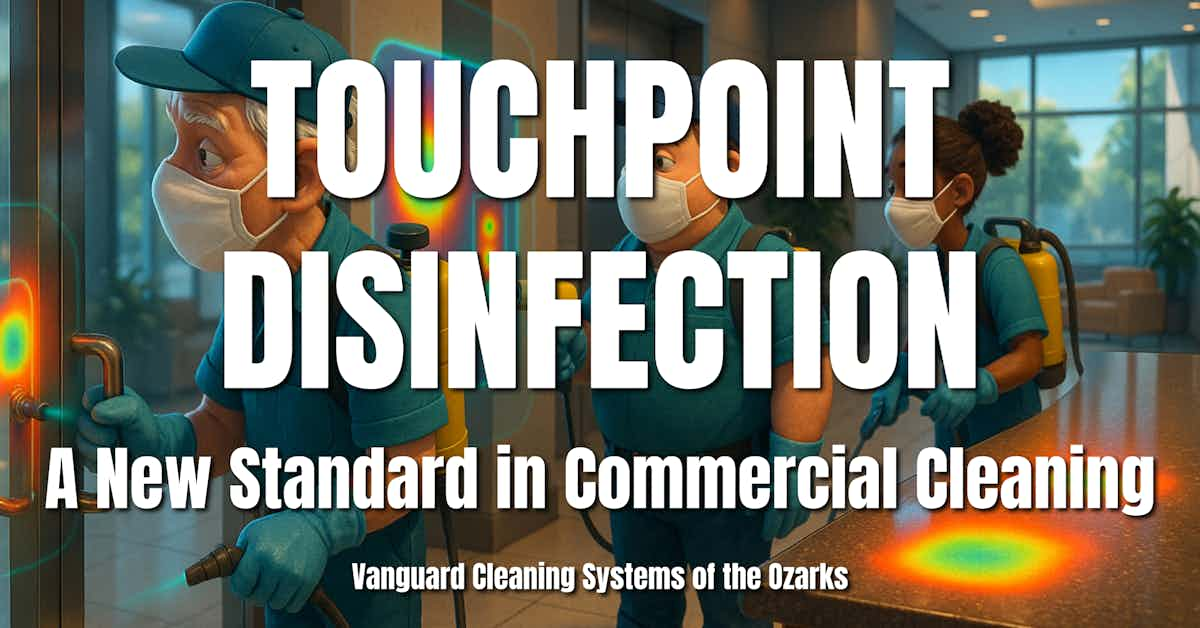Touchpoint disinfection is no longer optional—it’s the new benchmark for protecting health in every shared commercial space.

Why Touchpoint Disinfection Is Reshaping Commercial Cleaning
Commercial cleaning has entered a new era—one where hygiene isn't just expected, it's demanded. The shift began during the COVID-19 pandemic and continues to reshape how businesses approach safety in shared spaces. At the center of this change is touchpoint disinfection.
High-touch surfaces—like doorknobs, light switches, handrails, and elevator buttons—serve as invisible highways for bacteria and viruses. Traditional cleaning practices no longer meet modern health expectations. Instead, targeted disinfection strategies have become the benchmark for protecting customers, employees, and visitors.
Touchpoint disinfection isn't just a temporary fix. It’s fast becoming a permanent standard in commercial cleaning, backed by new research, verification technologies, and worker training protocols.
High-Touch Surfaces Pose Elevated Risks
Everyday objects are microbial hotspots
- Items like door handles, elevator buttons, light switches, and countertops are touched repeatedly by multiple people.
- These surfaces accumulate bacteria and viruses quickly, especially in high-traffic areas like lobbies, restrooms, and breakrooms.
- Without frequent cleaning, they become primary sources of cross-contamination.
Traditional cleaning methods leave gaps
- Alcohol and chlorine-based disinfectants are widely used but often lack residual activity.
- Manual wiping is inconsistent and may miss critical areas due to time constraints or lack of visibility.
- Some surfaces recontaminate within hours, especially in busy commercial settings.
Enhanced disinfection strategies extend protection
- Quaternary ammonium compounds and similar solutions provide longer-lasting microbial defense.
- Disposable wipes reduce cross-contamination risk compared to reusable cloths.
- Layering surface chemistry with frequency creates a stronger line of defense.
Verification Tools Expose Cleaning Gaps
Visual checks aren’t enough
- Clean doesn’t always mean disinfected. Many contaminated surfaces appear spotless to the naked eye.
- Relying on visual inspections alone can lead to a false sense of security and missed contamination.
Testing reveals real-time sanitation performance
- Tools like ATP meters measure organic material left behind after cleaning, offering immediate feedback.
- Culture swabs identify bacteria and viruses that standard wipe-downs may miss.
- These methods help spot weak links in cleaning routines that would otherwise go unnoticed.
Data drives accountability and improvement
- Verification results allow managers to fine-tune cleaning schedules and retrain staff when needed.
- Measurable outcomes foster consistency across shifts and locations.
- Sharing metrics with frontline teams increases awareness and ownership of disinfection quality.
Technology Enhances Detection and Precision
Thermal video identifies real-world touchpoints
- Computer vision systems using thermal imaging can detect where and how often surfaces are touched.
- This data highlights actual usage patterns—not just assumed ones—guiding more effective cleaning priorities.
- Surveillance-free and privacy-safe, this method offers a modern upgrade to observational audits.
Automated detection improves efficiency
- Touch maps generated from thermal data help staff focus on the most contaminated zones.
- Cleaning resources can be allocated based on usage intensity rather than fixed schedules.
- Reduces wasted labor and ensures high-risk areas are addressed more frequently.
Smarter targeting leads to safer environments
- Instead of cleaning everything equally, teams can clean the right areas at the right time.
- This shift increases impact without increasing cost or effort.
- When integrated into a broader hygiene strategy, it supports both health goals and operational efficiency.
Workforce Training Is Essential for Success
Protocols are only as strong as the people following them
- Even the best disinfection plans fail without consistent execution.
- Janitorial teams need clear, step-by-step instructions specific to each environment and surface type.
- Assumptions about “common knowledge” often result in skipped steps and uneven results.
Training builds confidence and consistency
- Competency-based programs ensure workers understand what to clean, how to clean it, and why it matters.
- Interactive demonstrations and repeatable drills help reinforce proper techniques.
- Ongoing refreshers keep skills sharp and adapt to changing health guidelines.
Tailored guidance reduces risk across industries
- Office buildings, retail spaces, medical clinics, and warehouses all require different disinfection strategies.
- Customized training ensures each team is prepared to meet their space-specific needs.
- A well-trained workforce protects both public health and business continuity.
Automated Systems Improve Consistency
Manual cleaning has built-in variability
- Human fatigue, time pressure, and inconsistent technique often lead to missed spots.
- Different staff may interpret cleaning protocols differently, reducing reliability.
- Routine errors compound over time, especially in busy commercial environments.
Automation ensures repeatable performance
- Washer-disinfectors, UV-C devices, and electrostatic sprayers apply consistent coverage and dosing.
- Programmable cycles reduce dependence on operator judgment.
- Built-in sensors track completion and performance metrics, improving oversight.
Standards support safe implementation
- International guidelines, like ISO 15883, set requirements for cleaning systems and validation methods.
- These standards improve safety, reproducibility, and cross-site uniformity.
- As automated systems become more affordable, they’re increasingly adopted across sectors seeking better hygiene outcomes.
Touchpoint Disinfection in Commercial Cleaning – FAQs
What is touchpoint disinfection?
Touchpoint disinfection targets frequently touched surfaces like door handles, light switches, and handrails to reduce the spread of germs.
Why is touchpoint disinfection important in commercial spaces?
High-touch surfaces are hotspots for bacteria and viruses. Regular disinfection reduces the risk of transmission in shared environments.
How often should high-touch areas be disinfected?
Disinfection frequency depends on foot traffic. In busy areas, surfaces may need cleaning multiple times per day.
Are traditional cleaning methods still effective?
Standard methods help but often leave behind residual contamination. Advanced disinfectants and protocols provide longer-lasting protection.
What tools help verify cleaning effectiveness?
ATP testing and microbial swabs reveal contamination levels, helping teams adjust protocols and improve results.
Can technology help identify which surfaces need cleaning?
Yes. Thermal imaging and computer vision detect real-world touchpoints, helping prioritize cleaning based on actual use.
Do employees need special training for touchpoint disinfection?
Yes. Proper technique and chemical use are essential. Competency-based training ensures consistent, effective disinfection.
What automated systems are used for touchpoint cleaning?
UV-C devices, electrostatic sprayers, and washer-disinfectors deliver consistent results and reduce reliance on manual labor.
References
- Casini, B., Righi, A., De Feo, N., Totaro, M., Giorgi, S., Zezza, L., Valentini, P., Tagliaferri, E., Costa, A., Barnini, S., Baggiani, A., Lopalco, P., Malacarne, P., & Privitera, G. (2018). Improving Cleaning and Disinfection of High-Touch Surfaces in Intensive Care during Carbapenem-Resistant Acinetobacter baumannii Endemo-Epidemic Situations. International Journal of Environmental Research and Public Health, 15. https://doi.org/10.3390/ijerph15102305
- Leest, L., Kawczynski, R., Lipp, F., & Barrientos, R. (2012). Identifying potential areas of infectivity on high-touch locations in the OR.. AORN journal, 96 5, 507-12 . https://doi.org/10.1016/j.aorn.2012.07.012
- Ma, G., Ross, W., Tucker, M., Hsu, P., Buckland, D., & Codd, P. (2021). Touch-Point Detection Using Thermal Video With Applications to Prevent Indirect Virus Spread. IEEE Journal of Translational Engineering in Health and Medicine, 9. https://doi.org/10.1109/JTEHM.2021.3083098
- Richard, S. (2020). High Touch Surface COVID-19 Cleaning and Disinfecting: Workforce Health and Safety Preparation. The Journal of medical research, 20, 7-11. https://doi.org/10.34257/gjmrkvol20is5pg7
- Mcdonnell, G. (2008). Advances and Standards in Cleaning and Disinfection. Iryou kikigaku (The Japanese journal of medical instrumentation). https://doi.org/10.4286/jjmi.78.266
Conclusion
Touchpoint disinfection has moved from a reactive measure to a foundational element of modern commercial cleaning. High-touch surfaces carry elevated risk, and traditional cleaning methods no longer meet the expectations of post-pandemic hygiene standards.
Emerging tools—like ATP testing, thermal imaging, and automated cleaning systems—bring greater precision and consistency to disinfection efforts. But tools alone aren’t enough. Success depends on clearly defined protocols, ongoing staff training, and measurable results.
Businesses that prioritize targeted surface hygiene build safer environments, protect their workforce, and earn the trust of customers in an increasingly health-conscious world.
Vanguard Cleaning Systems of the Ozarks' franchise-owned custodial service provider business cleans more than 8M sq. ft. weekly, maintaining an industry-topping 95+% of its customer base, year-over-year, and boasting more than 60 5-star Google reviews.
Need more capability from your vendor partners? --Let's talk.
In Oklahoma, dial 918-960-4450
In Arkansas, dial 479-717-2410
In Missouri, dial 417-812-9777

